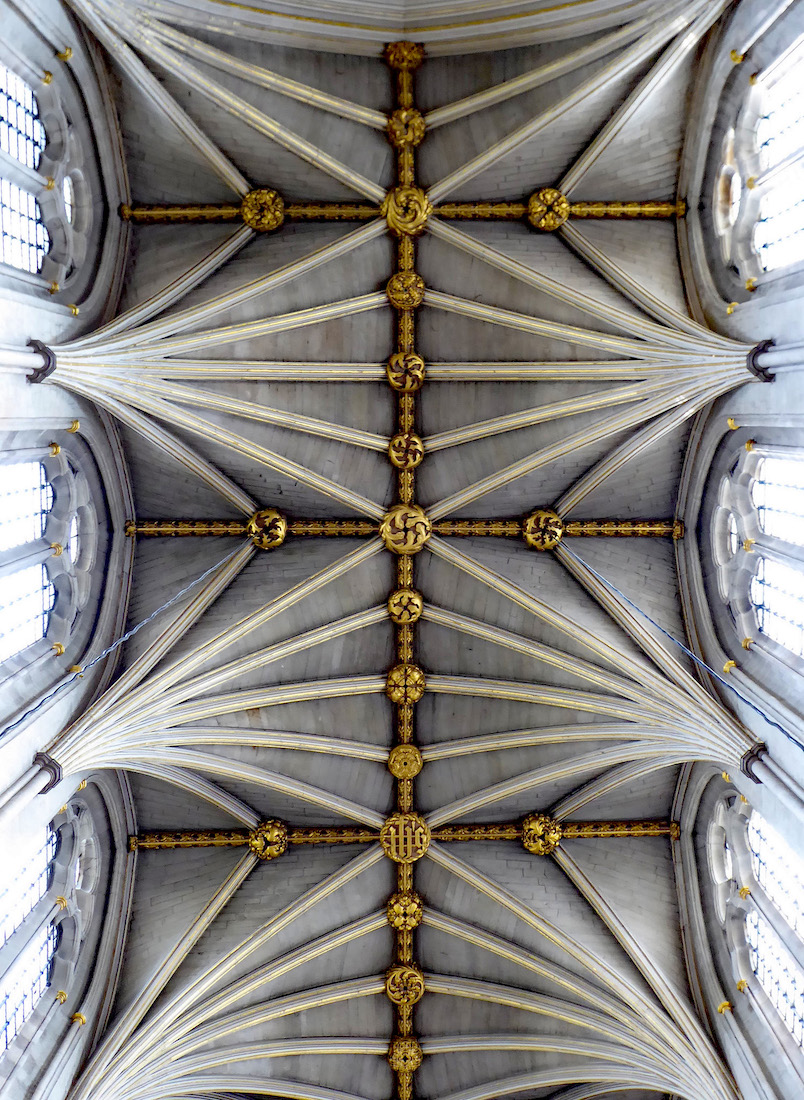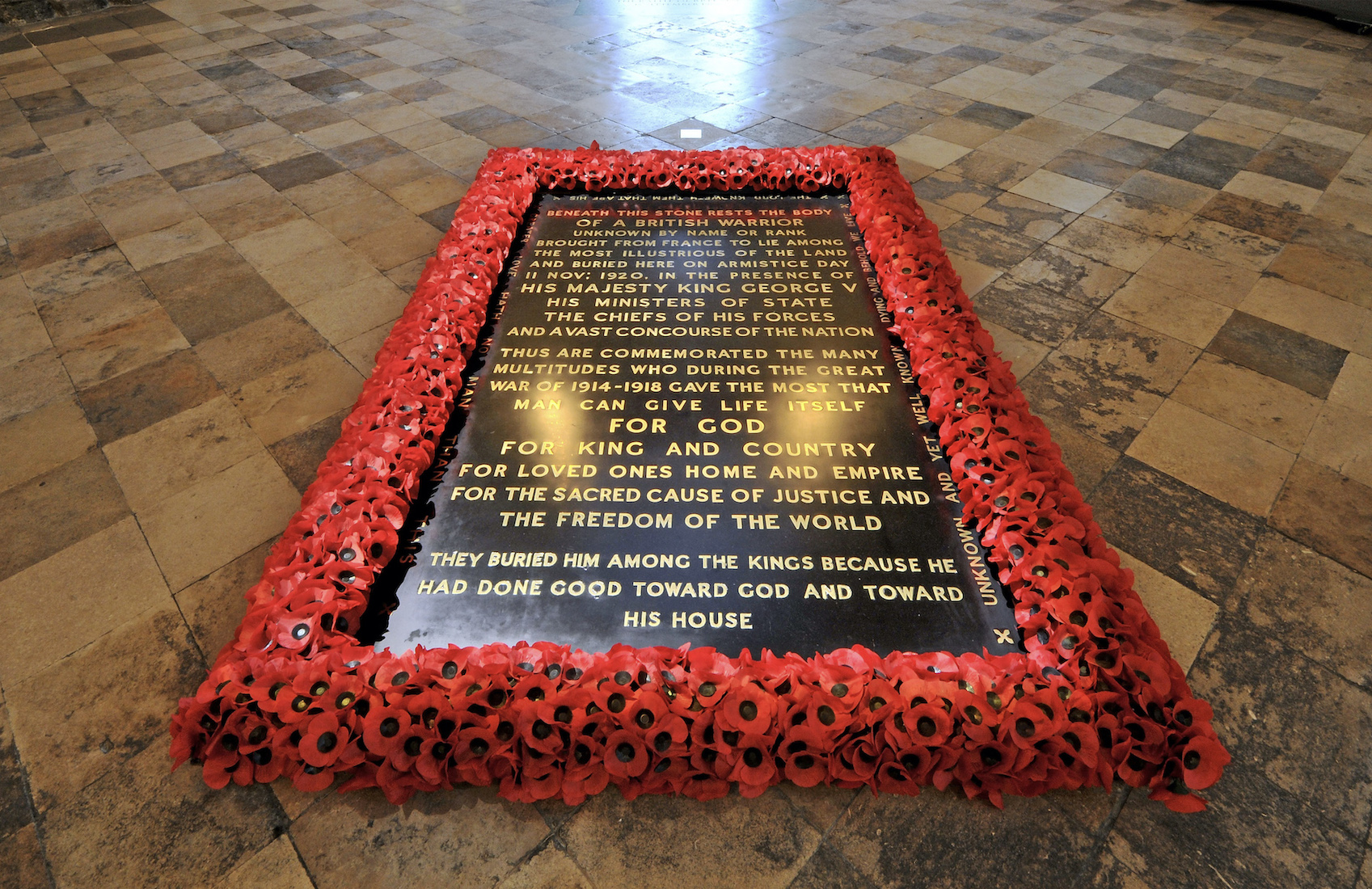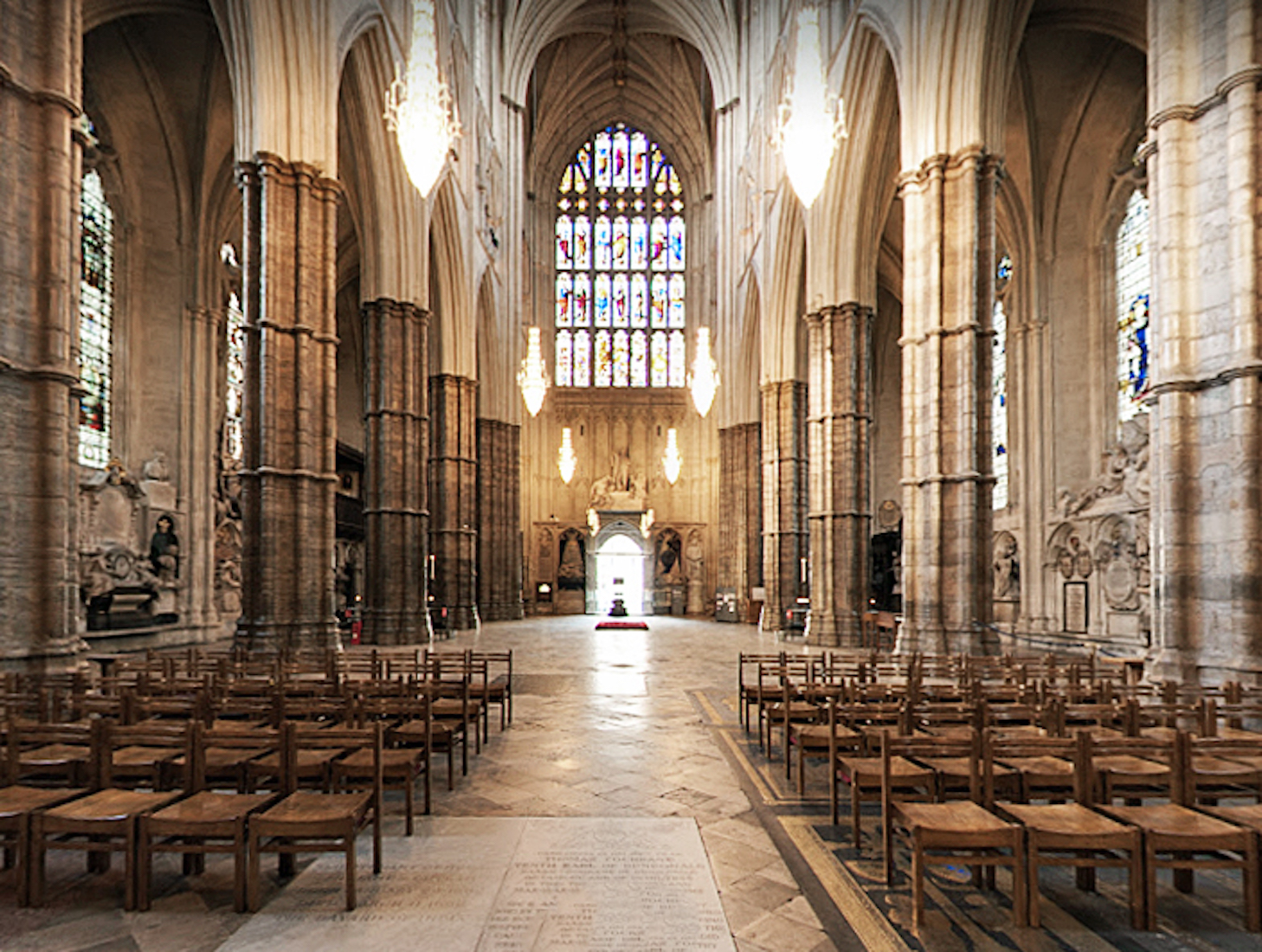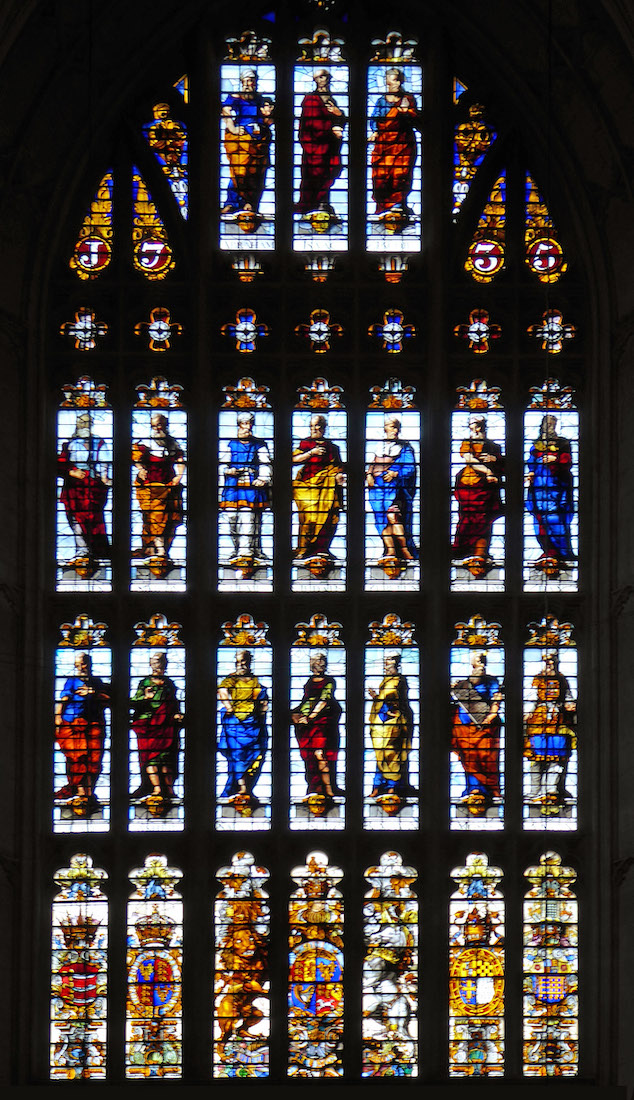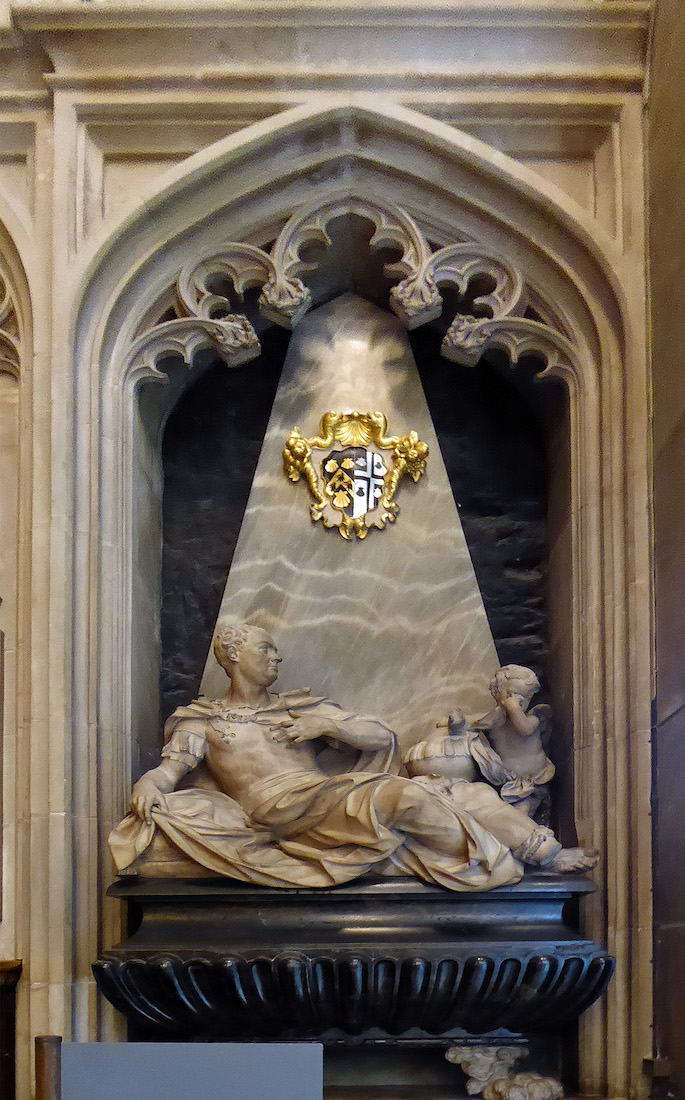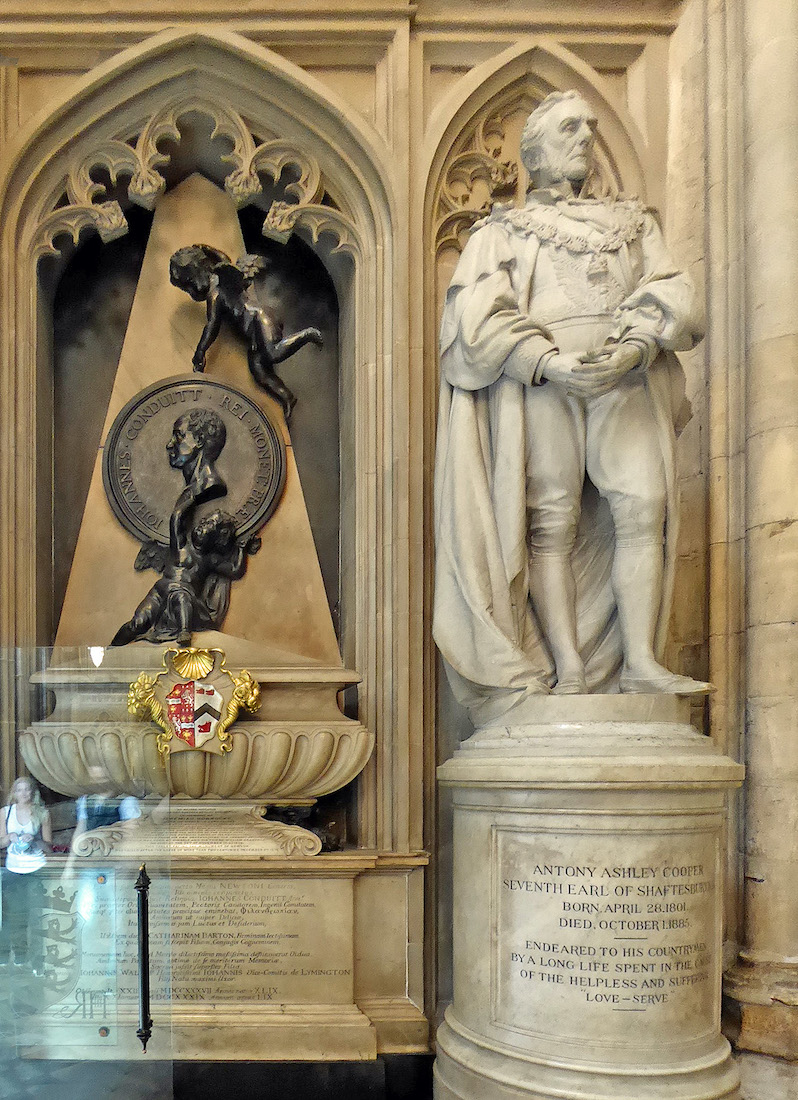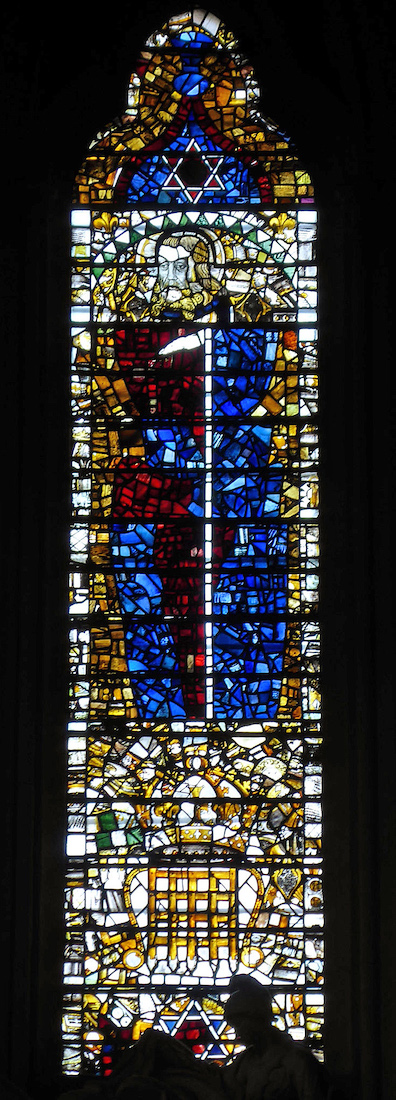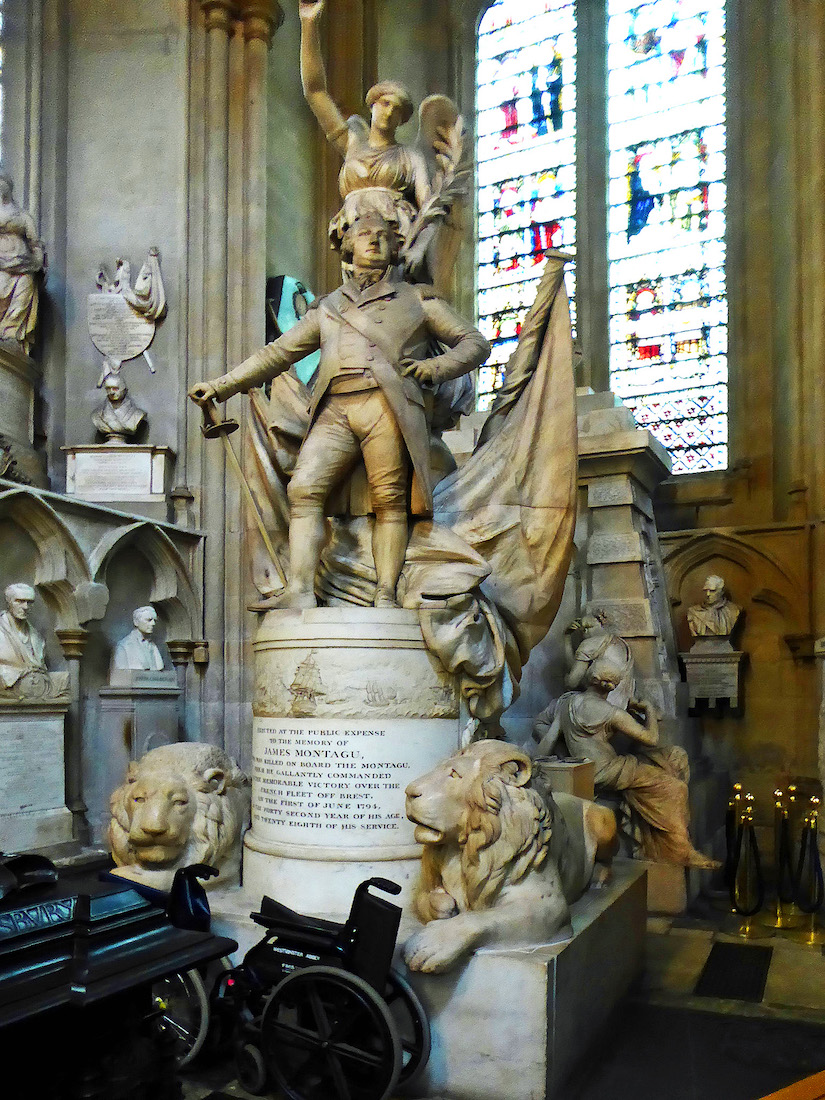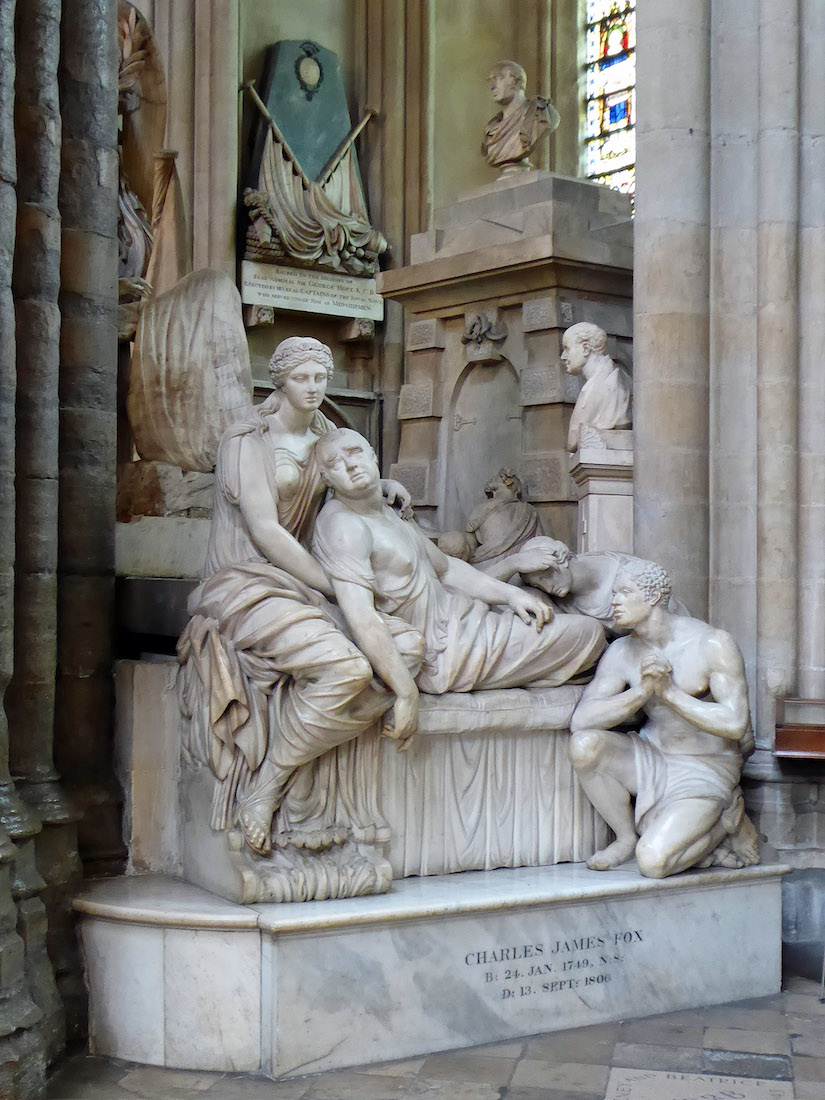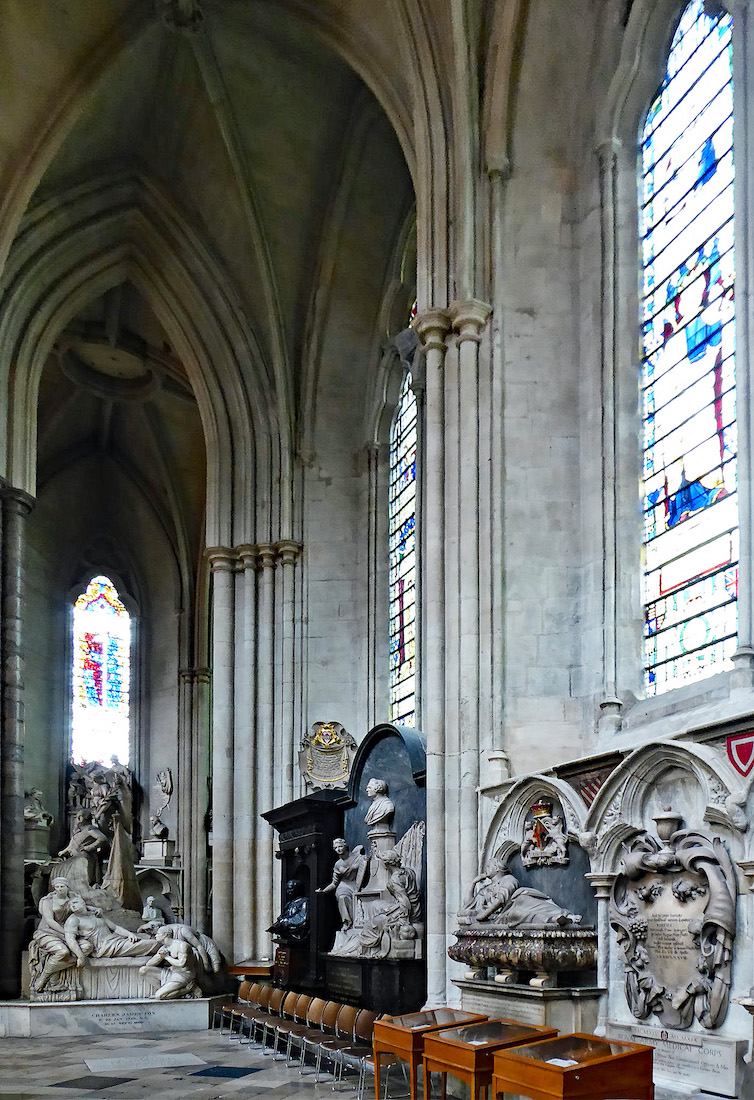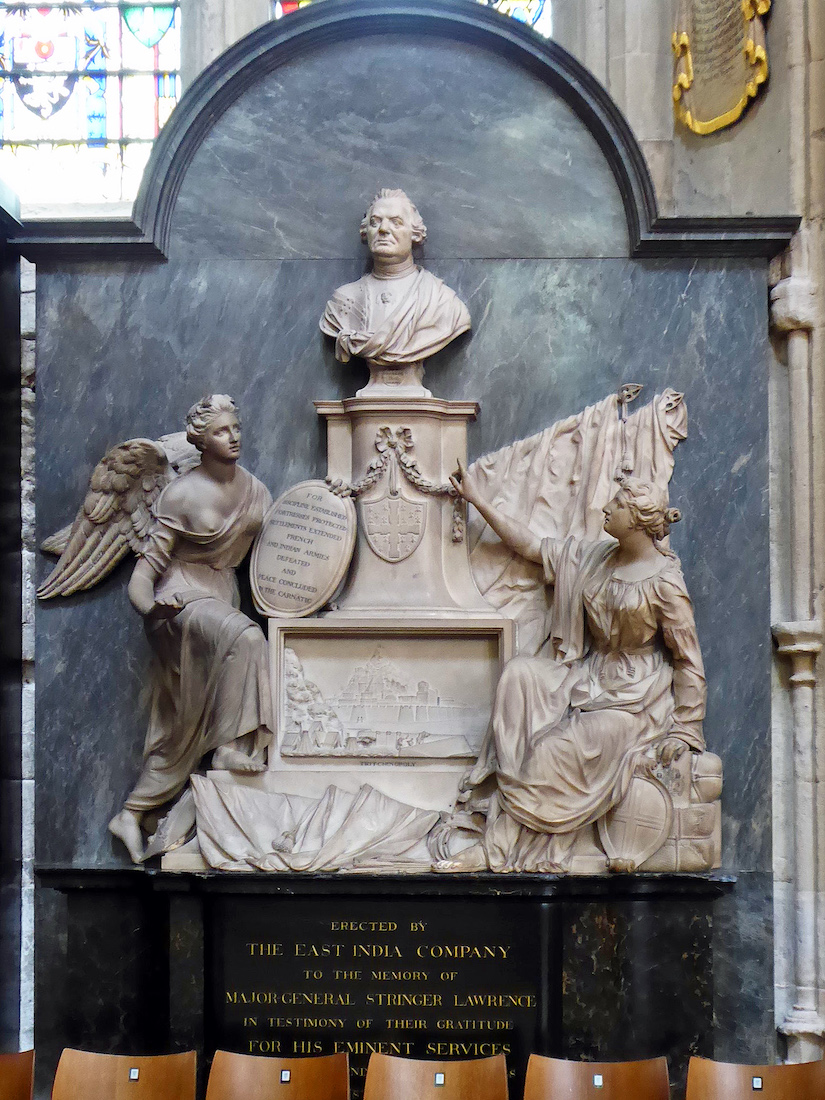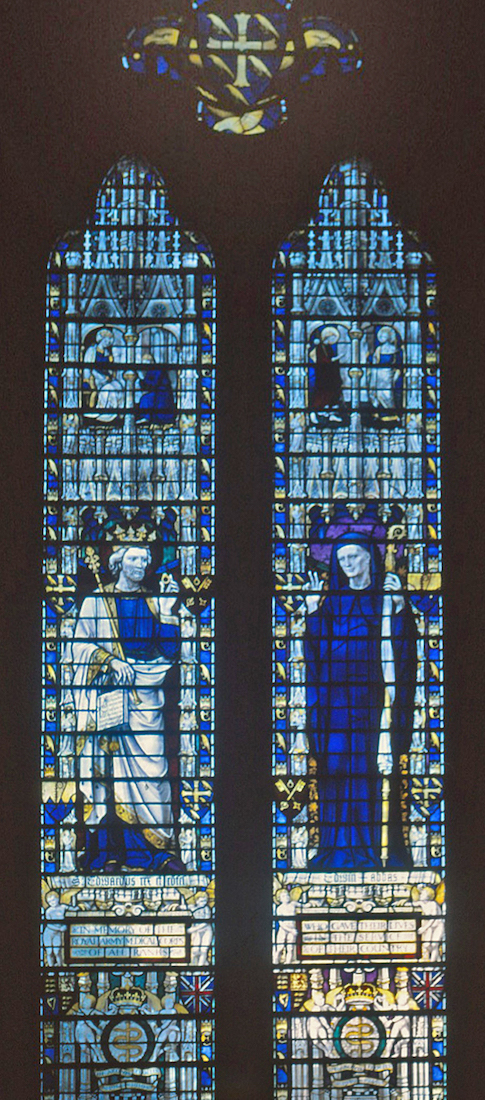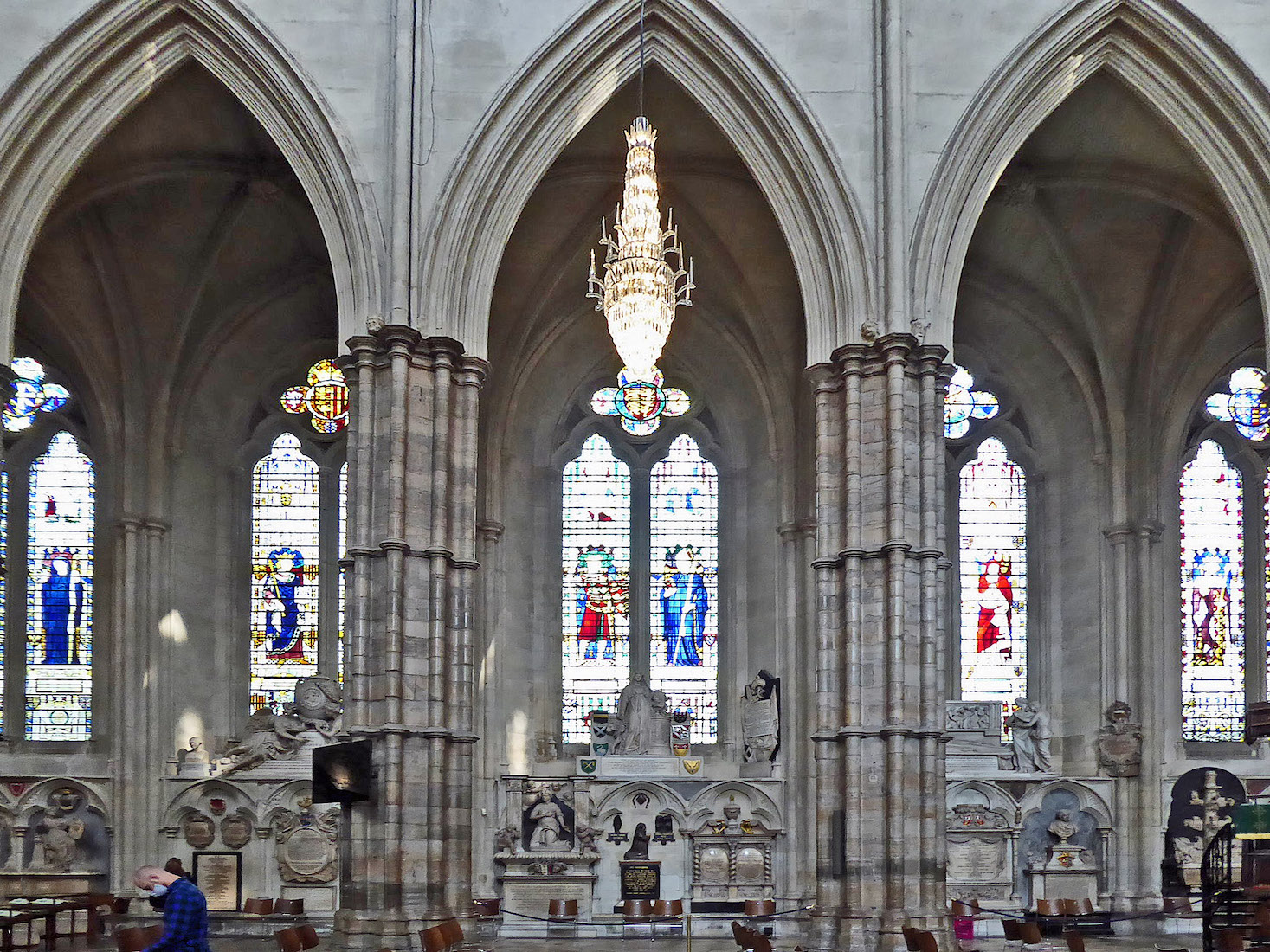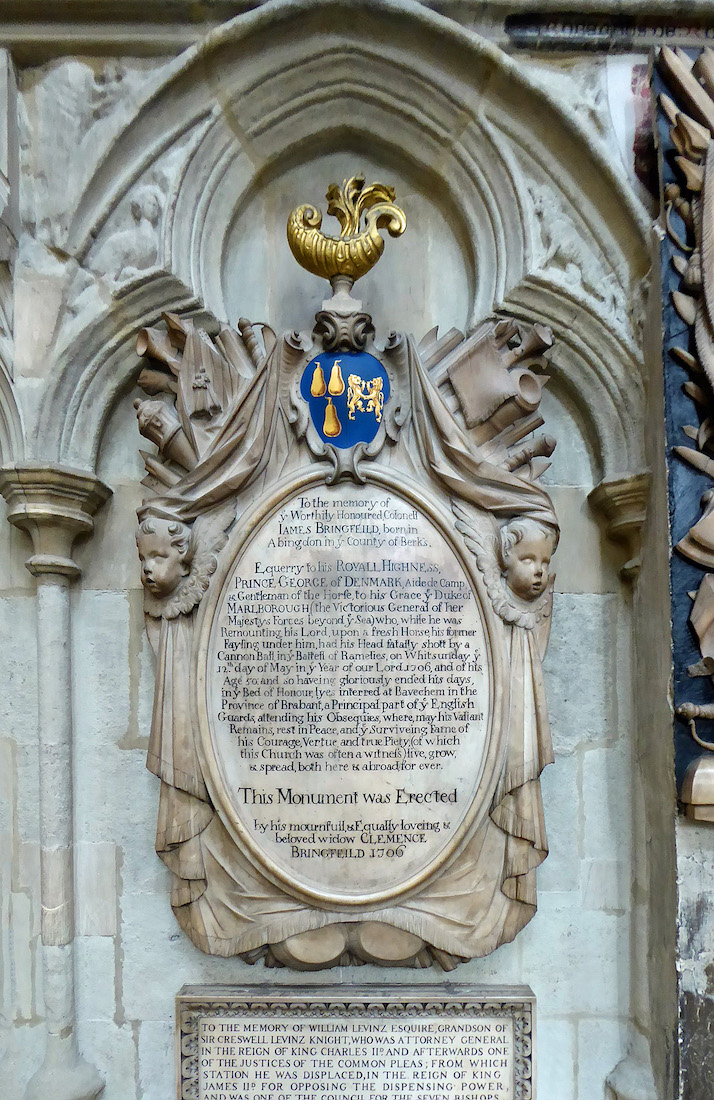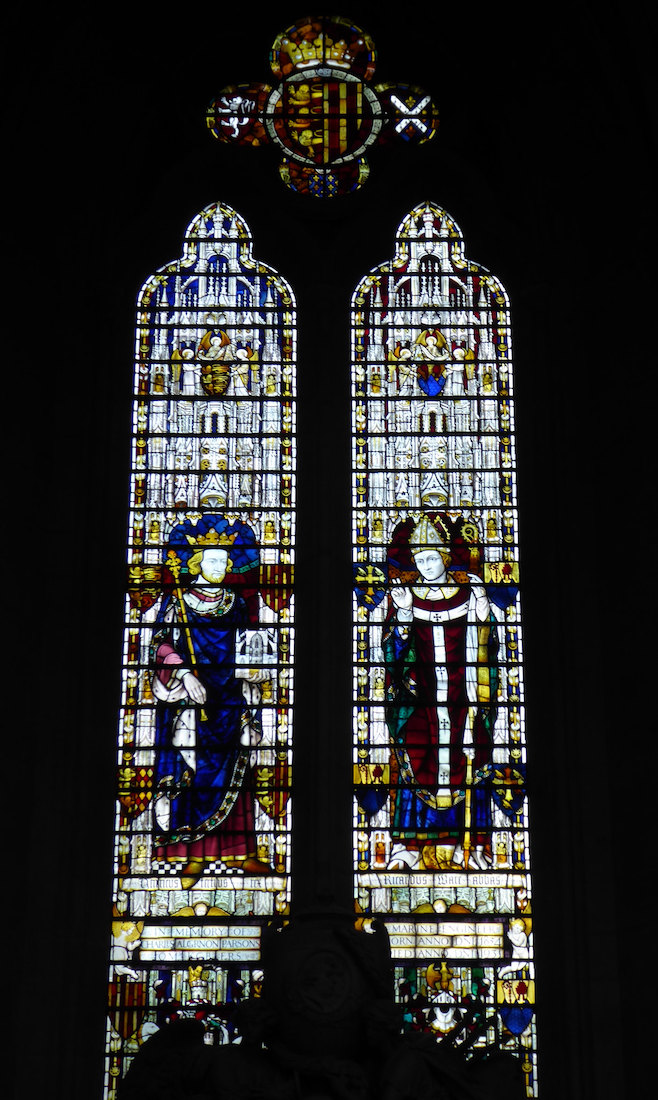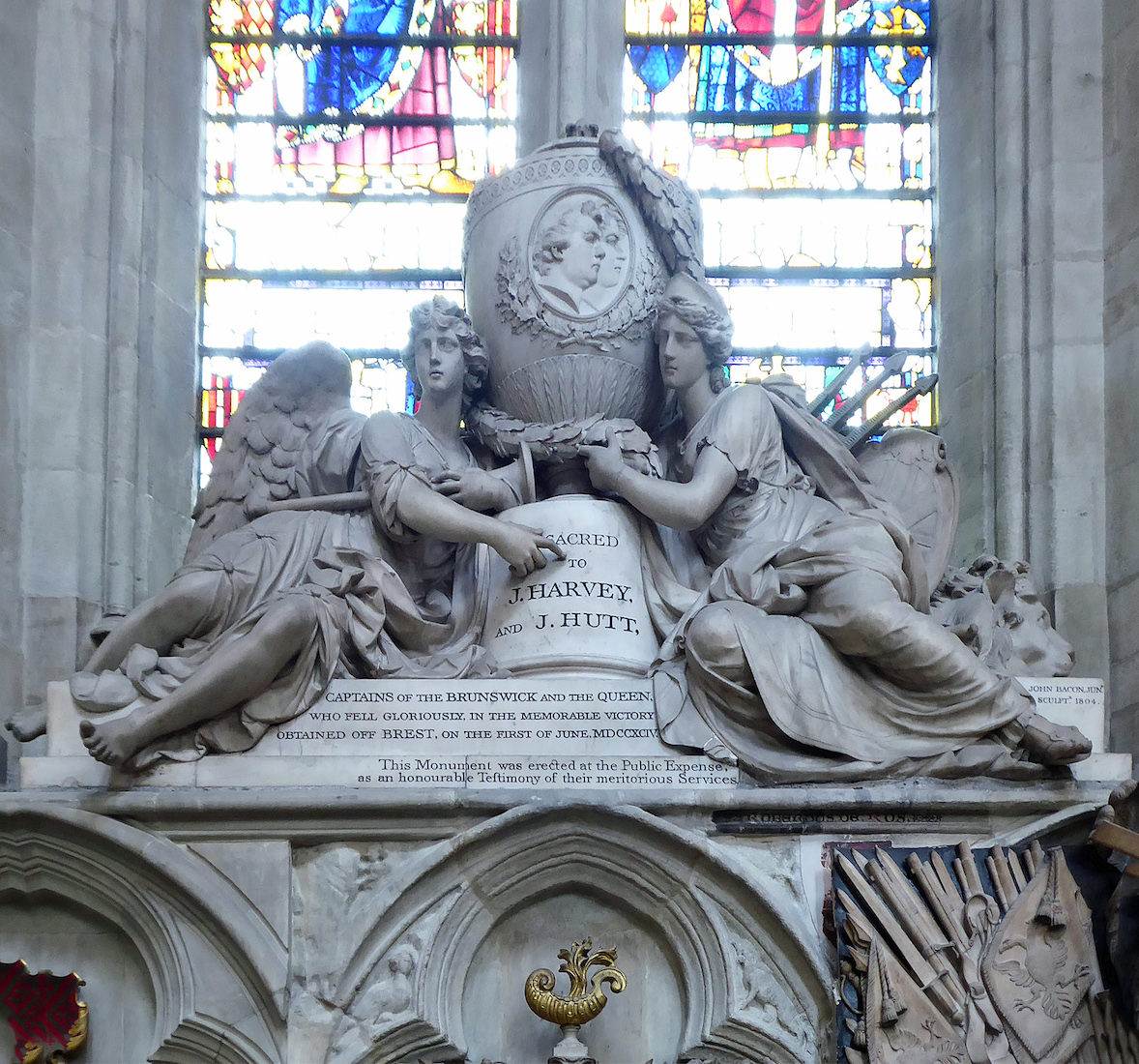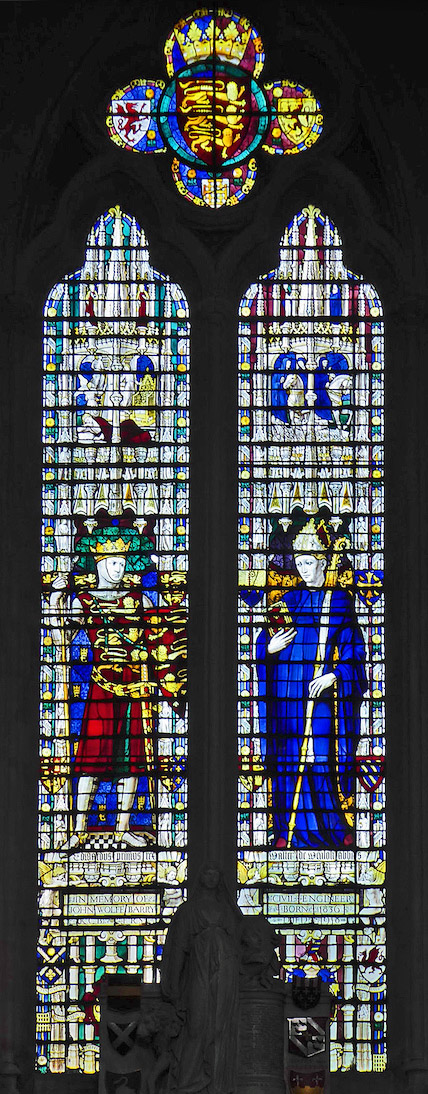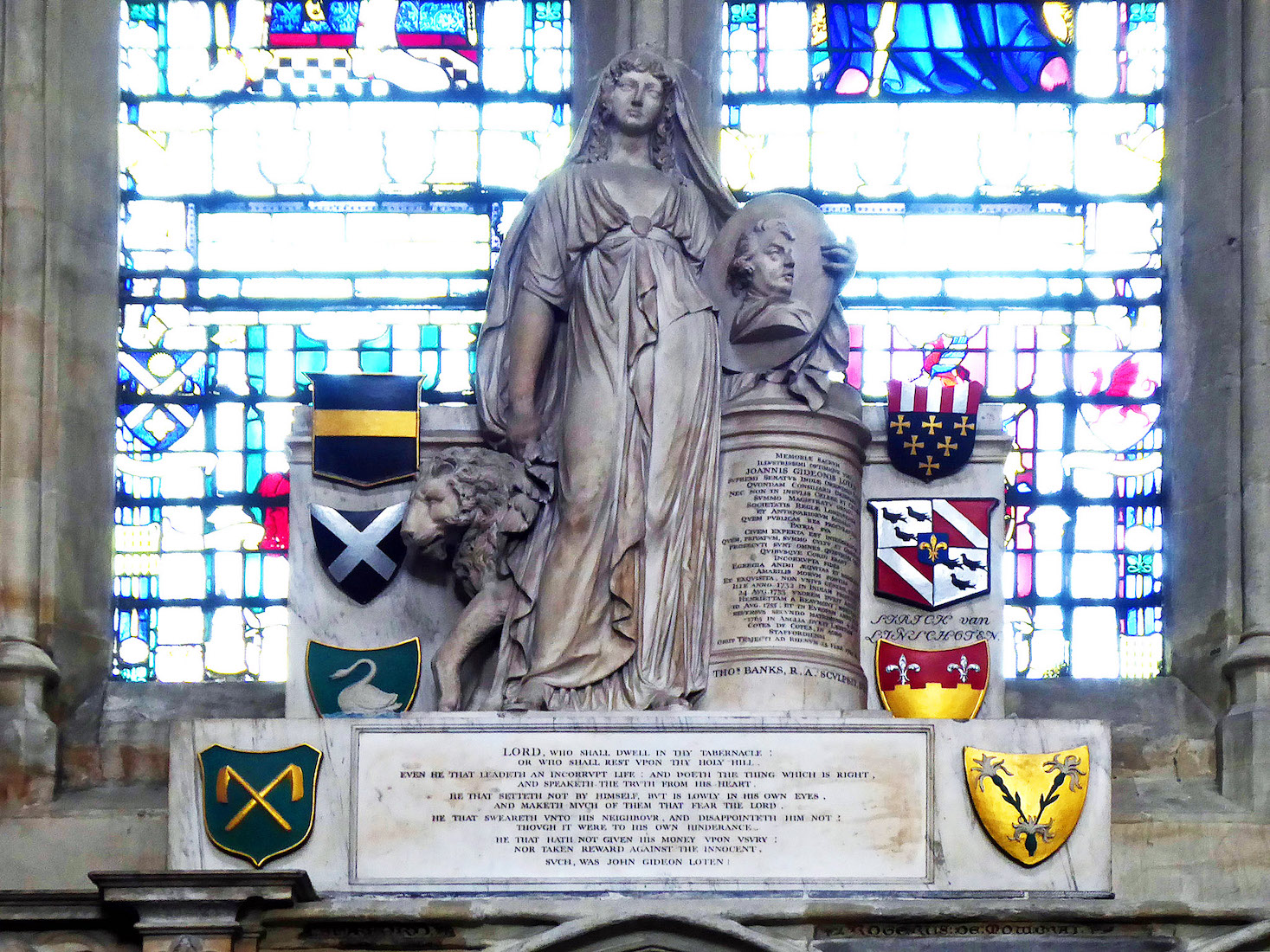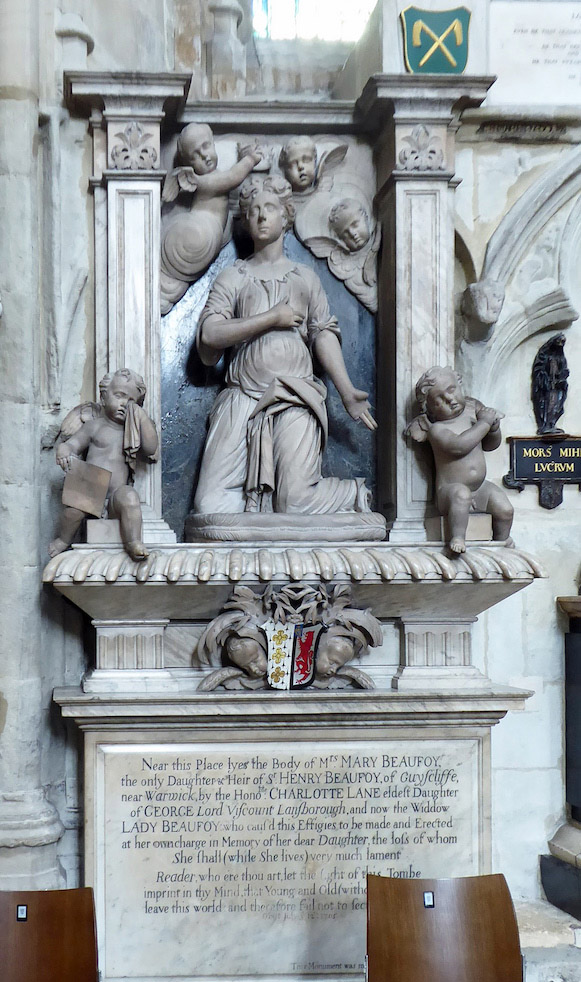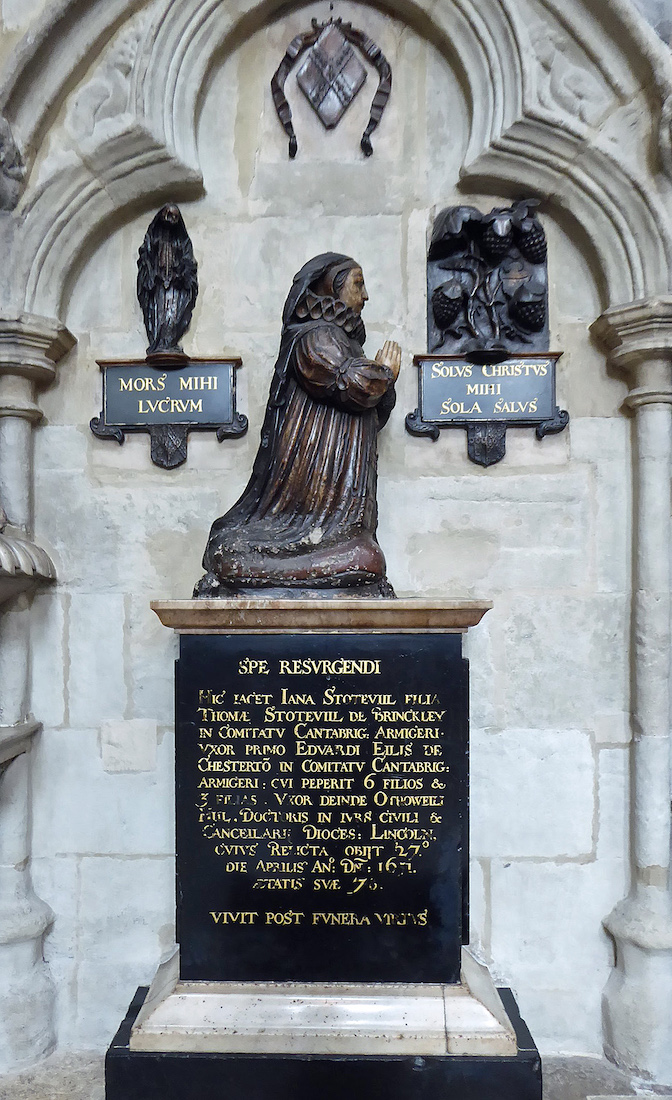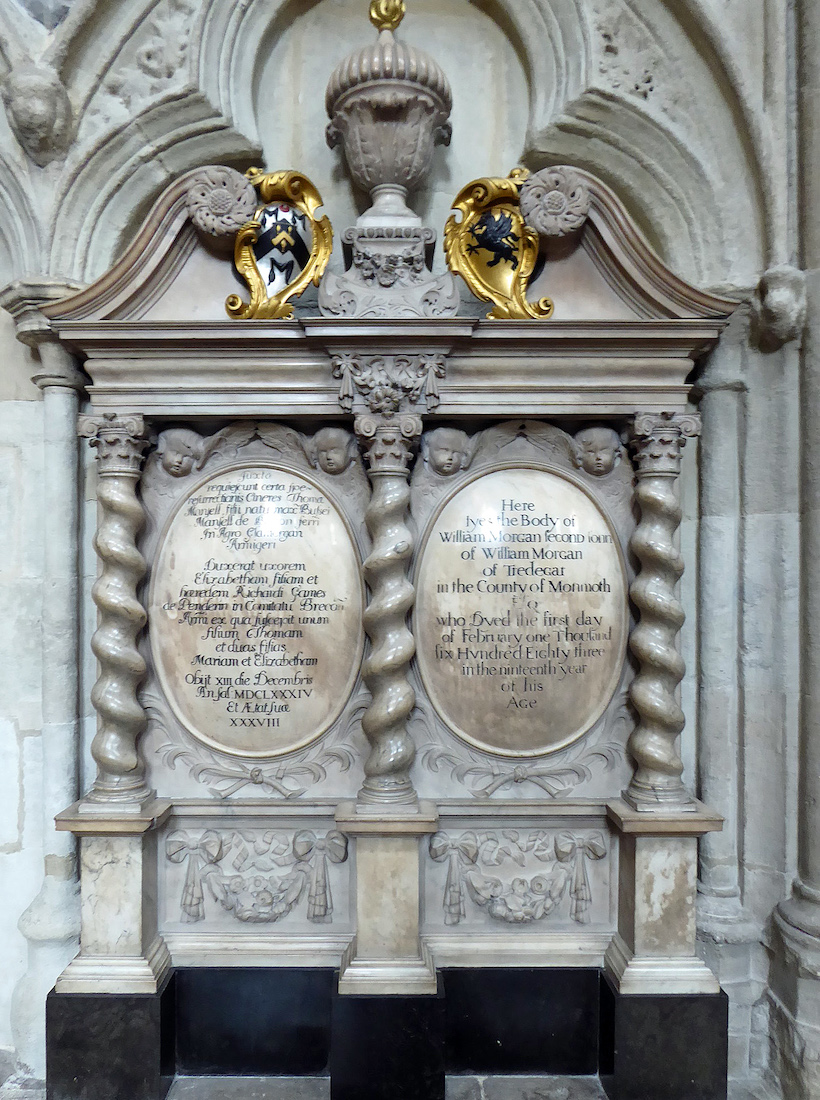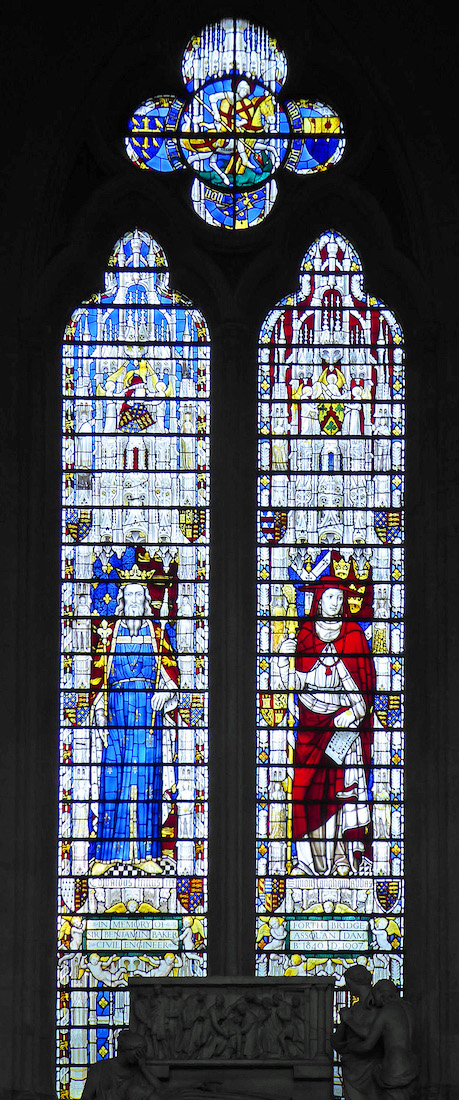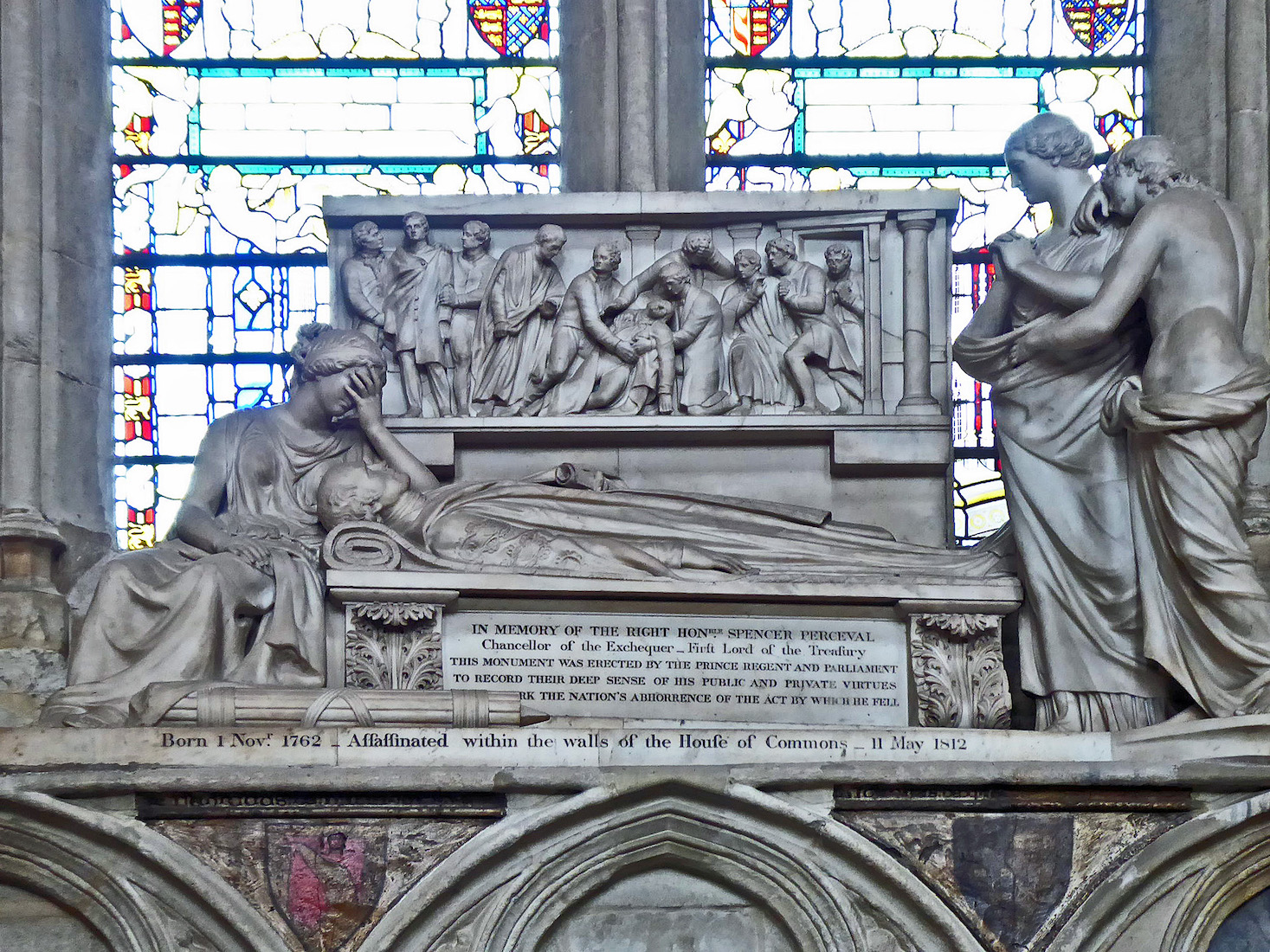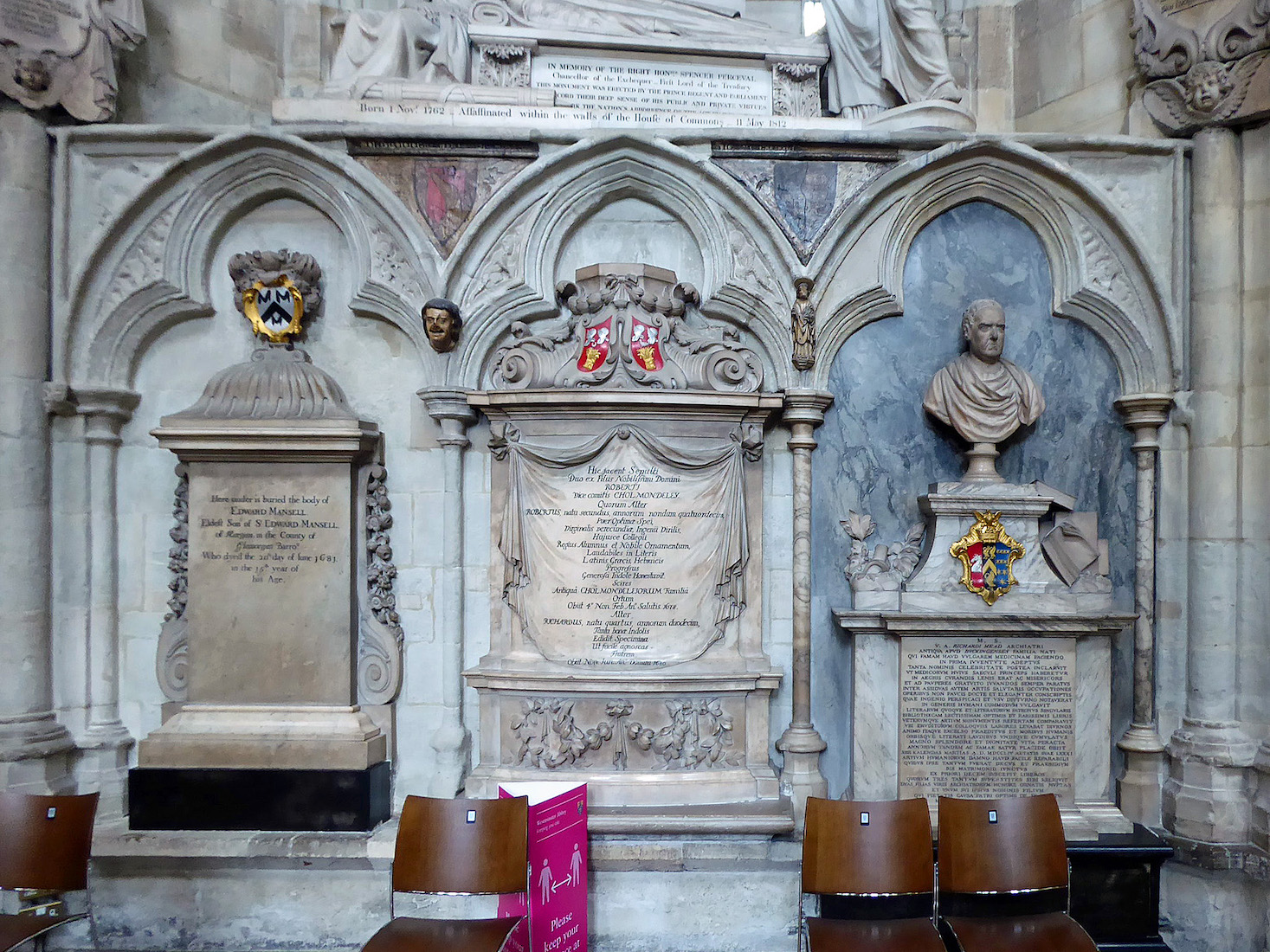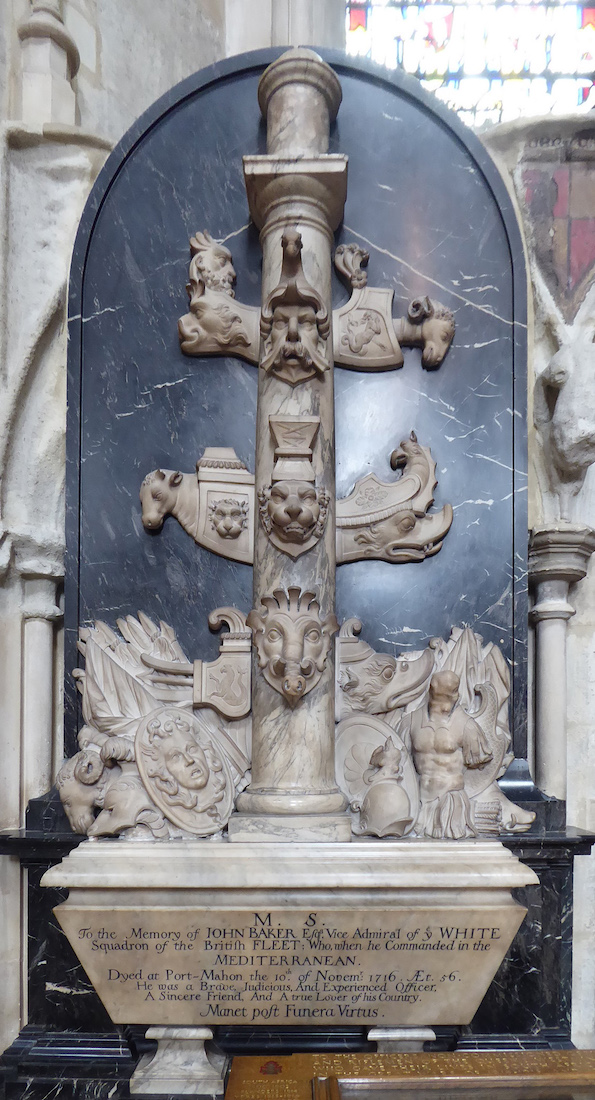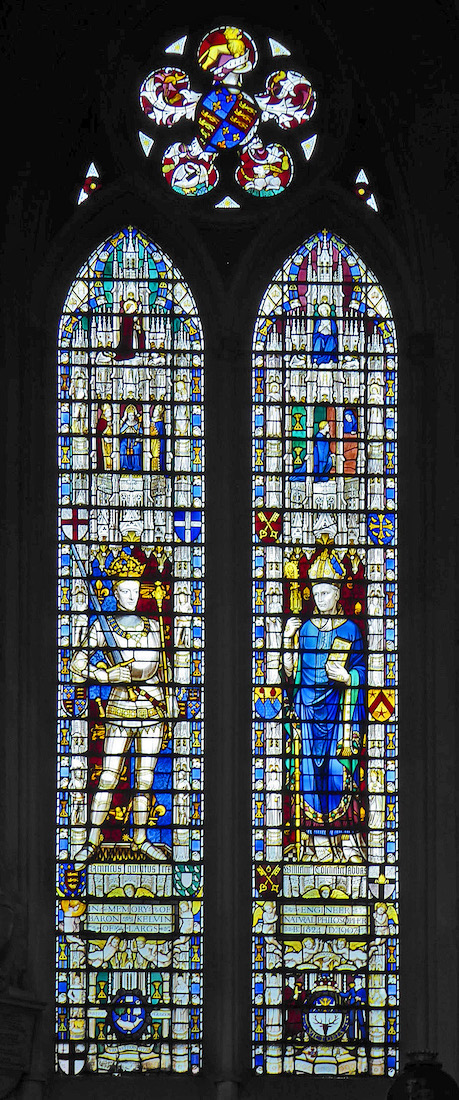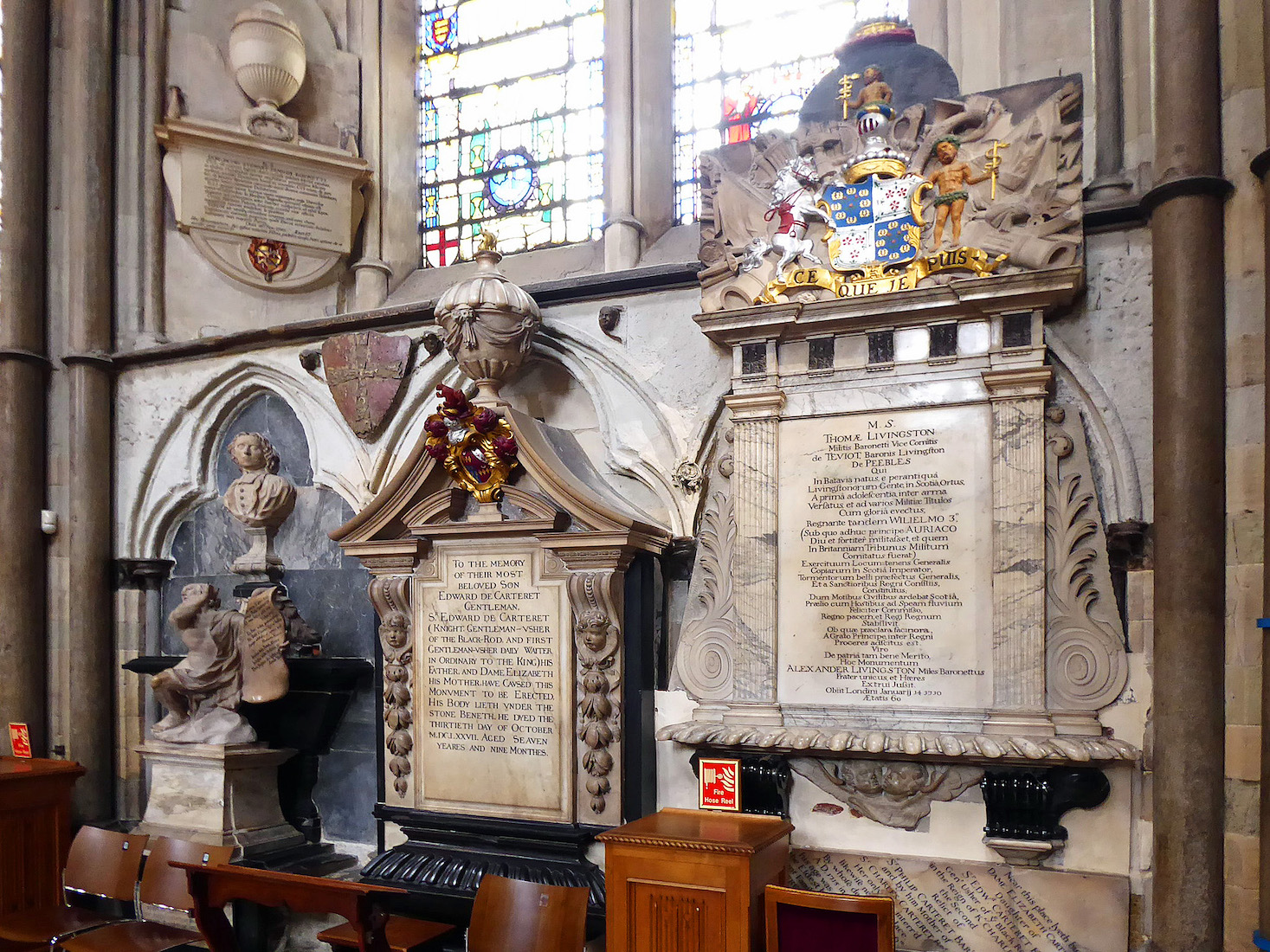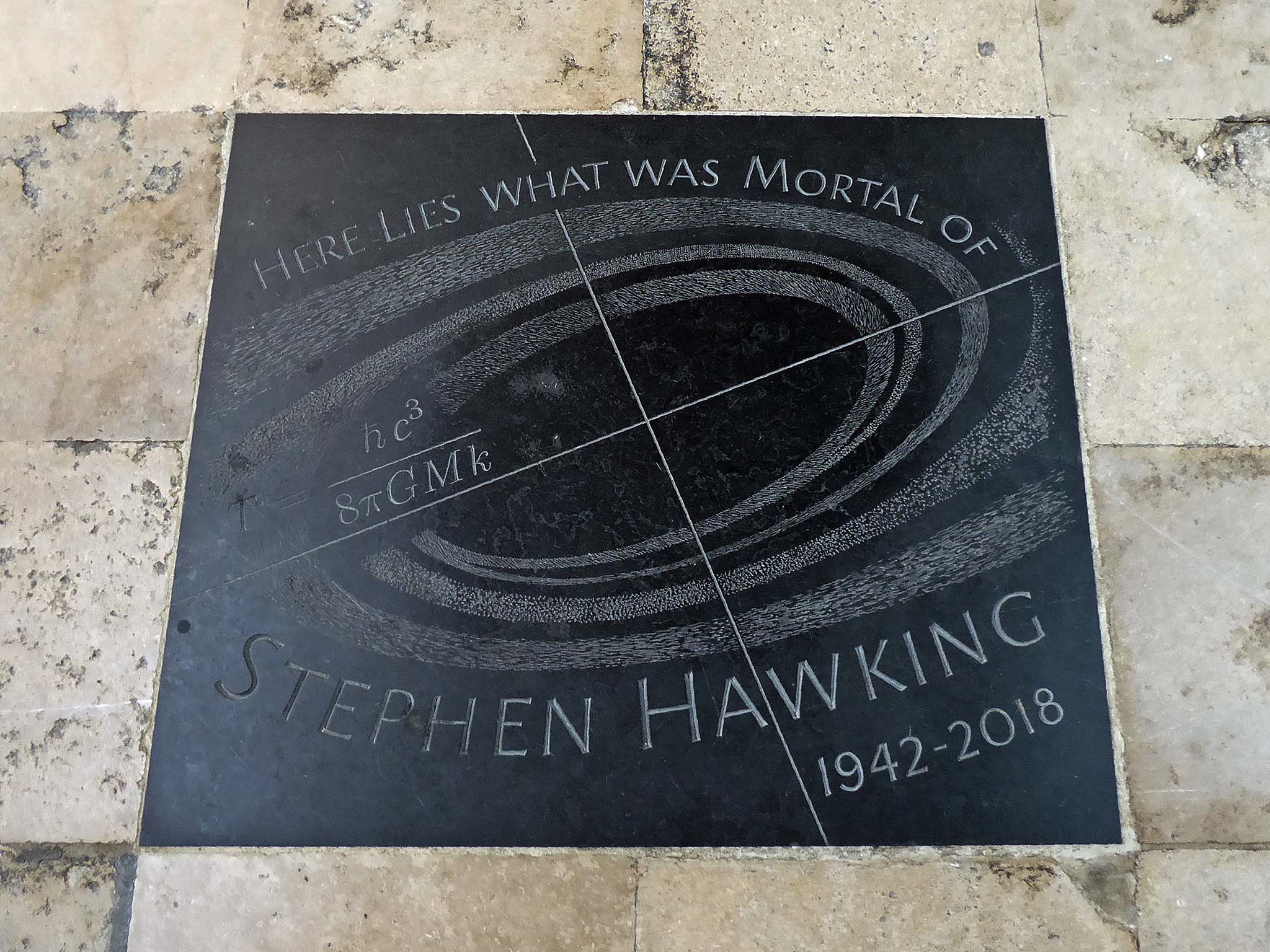B. NAVE

We stand near the West doors and admire the nave which is truly spectacular. Massive columns support the Gothic arches which soar to the vaulted roof which reaches a height of 101 feet (31 metres). Light is provided by wonderful hanging lamps. At the sides are large colourful stained glass windows, and walls of monuments, but these are not intrusive in this large space. The floor is covered with a well-worn diagonal tessellation of square pavers, and before us is the vivid Grave of the Unknown Warrior. A pair of well known icons faces us from nearby columns: at left the ‘Mother of God’ icon showing Mary pointing to the Christ child, and at right Christ himself. And in the distance we see the nave altar and the golden quire screen. [Photo Credit: Westminster Abbey] INDEX
B2. VAULTING AMT
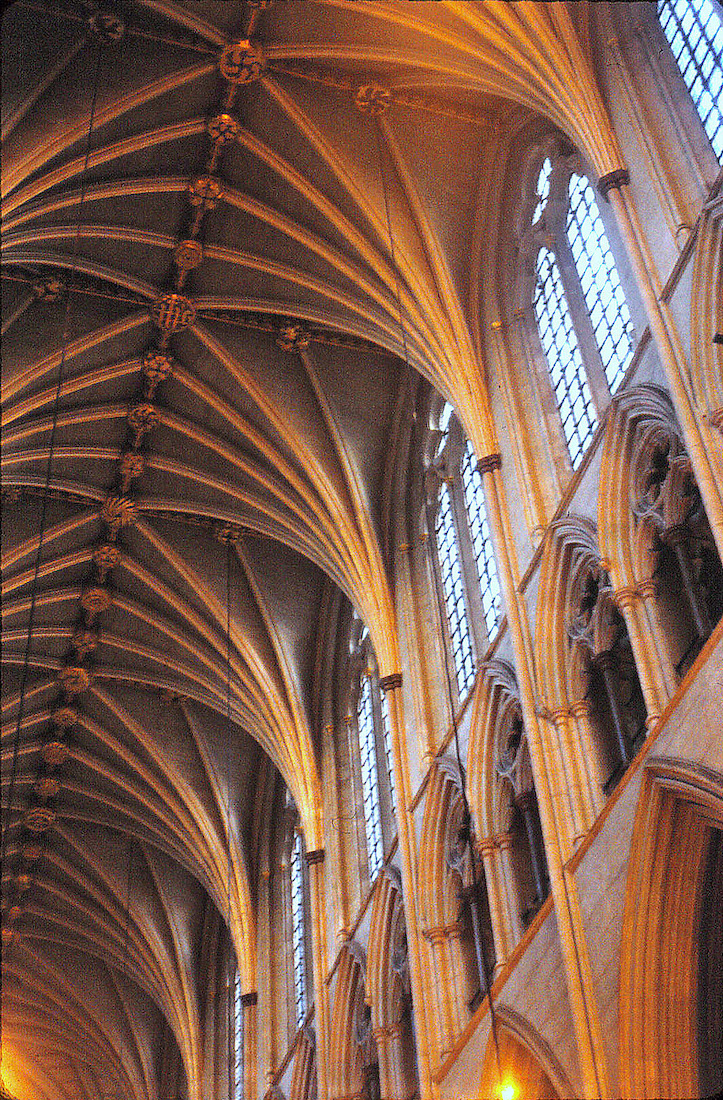
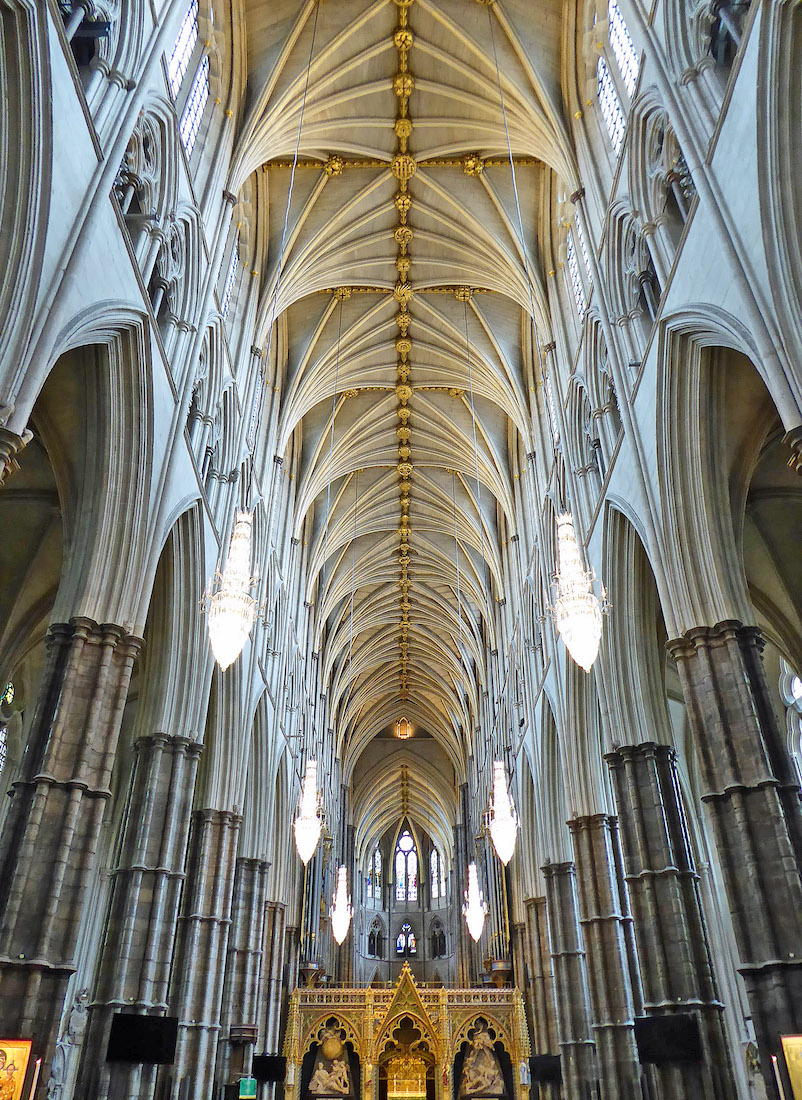
Extra height is given to the nave by tall clerestory windows, and an extra triforium arcade layer above the main Gothic arches. The present nave was nearly 150 years in building and was finally completed in 1517.
B3. VAULTING DETAIL AMT
The vaulting of the nave is uncomplicated, being described as ‘early English groined vaulting with intermediate ribs’. The golden bosses are interesting, with a large ’ihs’ (short for Jesus’) featured.
B4. UNKNOWN WARRIOR WA
The British grave of the Unknown Warrior (often known as ‘The Tomb of the Unknown Warrior’) holds an unidentified member of the British armed forces killed on a European battlefield during the First World War. He was given a state funeral and buried in Westminster Abbey, London on 11 November 1920, simultaneously with a similar interment of a French unknown soldier at the Arc de Triomphe in France. [Photo Credit: Westminster Abbey]
B5. WEST NAVE GSV
We walk to the centre of the nave and look back to appreciate the Great West Window. We notice that there is a large monument either side of the West doors. [Photo Credit: Google SV]
B6. WEST WINDOW AMT
Sir James Thornhill designed the Great West Window which shows Abraham, Isaac and Jacob with various prophets and apostles. The window dates from 1735.
B7. WEST ENTRY MONUMENTS AMT AMT
The monument shown at left is just South of the West door, and is to Admiral Sir Thomas Hardy (d 1732). It is by Sir Henry Cheere (d. 1737). Lord Nelson was shot as he paced the decks of HMS Victory with Hardy, and as he lay dying, Nelson’s famous remark of ‘Kiss me, Hardy’ was directed at him. •• At right are the Conduitt & Cooper monuments. The monument to John Conduitt (d.1737) is also by Sir Henry Cheere. Politician and author John Conduitt succeeded Newton as Master of the Mint and preserved many of his personal papers. To the right is the statue of Antony Ashley Cooper, 7th Earl of Shaftesbury (d.1885). He was a prominent English politician during the Interregnum and the reign of King Charles II.
B8. NORTHWEST TOWER WINDOWS AMT WA
Shown at left is the West window of the North aisle, containing a (largely reconstructed) figure and other elements of medieval glass collected from different parts of the Church. •• The North tower window at right is in memory of Richard Trevithick, the famous Cornish inventor and engineer who was known as the ‘father of the locomotive engine’. It was presented to the Abbey by the President of the Institute of Civil Engineers and unveiled in the nave in 1888. [Photo2 Credit: Westminster Abbey]
B9. MONTAGU MONUMENT AMT
In this Northwest corner we find this monument to Captain James Montagu (d.1794) sculpted by John Flaxman , and erected in 1804. The inscription reads: Erected at the public expense to the memory of James Montagu, who was killed on board the Montagu, which he gallantly commanded in the memorable victory over the French fleet off Brest on the first of June 1794, in the forty second year of his age and twenty eighth of his service
B10. CECIL TOMB AMT
Also in the Northwest corner near the West door is this tomb with effigy of Robert Cecil, Marquess of Salisbury (d.1903) by Sir William Goscombe John. It was erected in 1909.
B11. FOX MONUMENT AMT AMT
At the West end of the North aisle we find this monument to statesman Charles James Fox (d.1806) by Sir Richard Westmacott. The monument was originally erected near his grave in the North transept in 1822 but moved to its present position a few decades later.
B12. NORTH BAY 1, WINDOW AND MONUMENT AMT AMT
We now walk along the North aisle from West to East, looking at the windows and monuments. We will navigate by the seven naturally occurring ‘bays’. This window in the first bay is by Sir Ninian Comper, 1919, and is part of a sequence in the North aisle depicting various medieval monarchs paired with their contemporary Abbots of Westminster. •• The monument below is to Major General Stringer Lawrence (d.1775), and is by W.Tyler.
B13. NORTH BAY 2, WINDOW AND MEMORIALS AMT AMT
Bay 2 contains the second Ninian Comper window, with monuments below. Sir John Ninian Comper (1864 – 1960) was a Scottish architect, described as one of the last of the great Gothic Revival architects. From left the monuments are to Anne, Countess of Clanricarde (d.1733), ‘Martha’, and Dr John Woodward (d.1728) (monument by Peter Scheemakers).
B14. NORTH NAVE, BAYS 3 – 7 AMT
If we stand back from the north wall we get a more general impression. Seen here are Bays 4 – 6, with side views of Bays 3 and 7. The lighting is of particular interest. The chandeliers are of Waterford lead crystal, but they have now been modified to supply largely wireless controlled LED lighting, capable of providing a wide variety of colours.
B15. NORTH BAY 3, WINDOW AND MEMORIALS AMT (x4)
Bay 3 contains another Ninian Comper window and the three illustrated monuments. In order from top these are to: • Colonel James Bringfeild (d.1706); • Robert Killigrew (d.1707) and his family (monument by Francis Bird); • Captain John Harvey & Captain John Hutt (both d.1794) (monument by John Bacon Jnr).
B16. NORTH BAY 4, WINDOW AND MONUMENTS AMT (x5)
North Bay 4 with another Comper window, and four monuments shown. From top, monument to : • John Gideon Loten (d.1789) by Thomas Banks (erected in 1793); • Mary Beaufoy (d.1705) (by Grinling Gibbons); • Jane Stoteville (d.1631, (the oldest monument in the nave of the Abbey); • William Morgan (d.1684) & Thomas Mansell.
B17. NORTH BAY 5, WINDOW AND MONUMENTS AMT (x3)
North Bay 5: another Comper window, and two monument views. The top monument closest to the window is to the assassinated prime minister Spencer Perceval (d.1812). The monument is by Richard Westmacott. • The grouping of monuments below remember Edward Mansell, and two others, lost in Latin text!
B18. NORTH BAY 6, WINDOW AND MONUMENTS AMT (x3)
There are two striking monuments in Bay 6. Shown at left a monument to Vice-Admiral John Baker (d.1716), sculpted with various naval trophies and figureheads by Francis Bird. • And at right a monument to Henry Priestman (d.1712), also by Francis Bird.
B19. NORTH BAY 7, WINDOW AND MONUMENTS AMT (x3)
And finally, in North Bay 7, three monuments, from left: • to Philip Carteret (d.1711) by Chevalier Claude David; • to Edward de Carteret; • to Thomas Livingston, Viscount Teviot (d.1711); as well as a stone in the pavement marking the burial of Stephen Hawking (1942 – 2018), placed between stones for Sir Isaac Newton and Charles Darwin.
B20. NAVE PULPIT GSV
We now leave the North aisle with its long row of windows and monuments! Standing close by is an early 16th century linenfold pulpit, which is traditionally said to be the one from which Archbishop Cranmer preached a coronation sermon. [Photo Credit: Google Street View]


